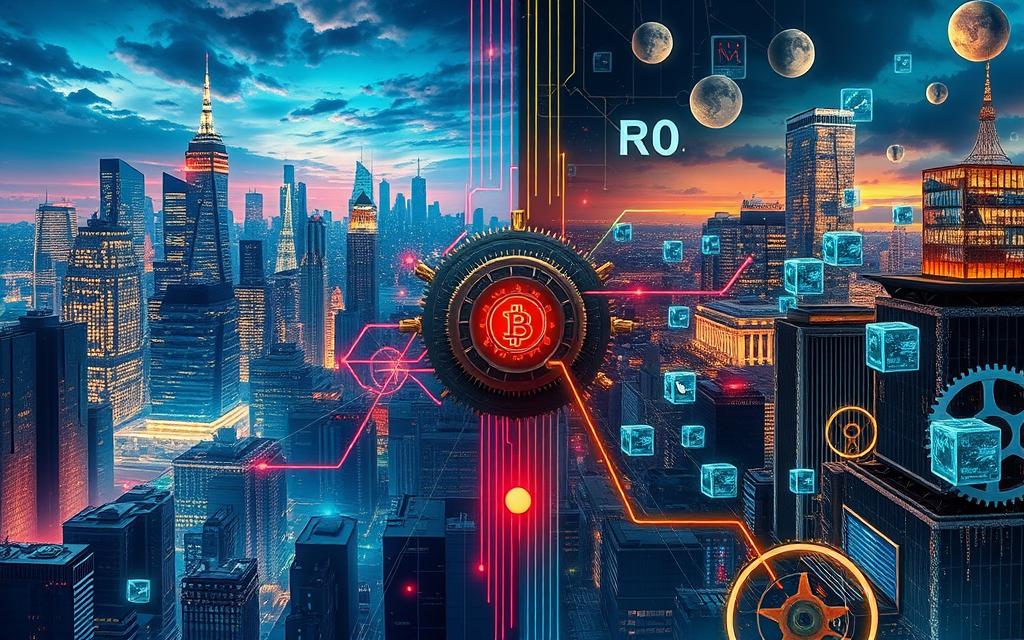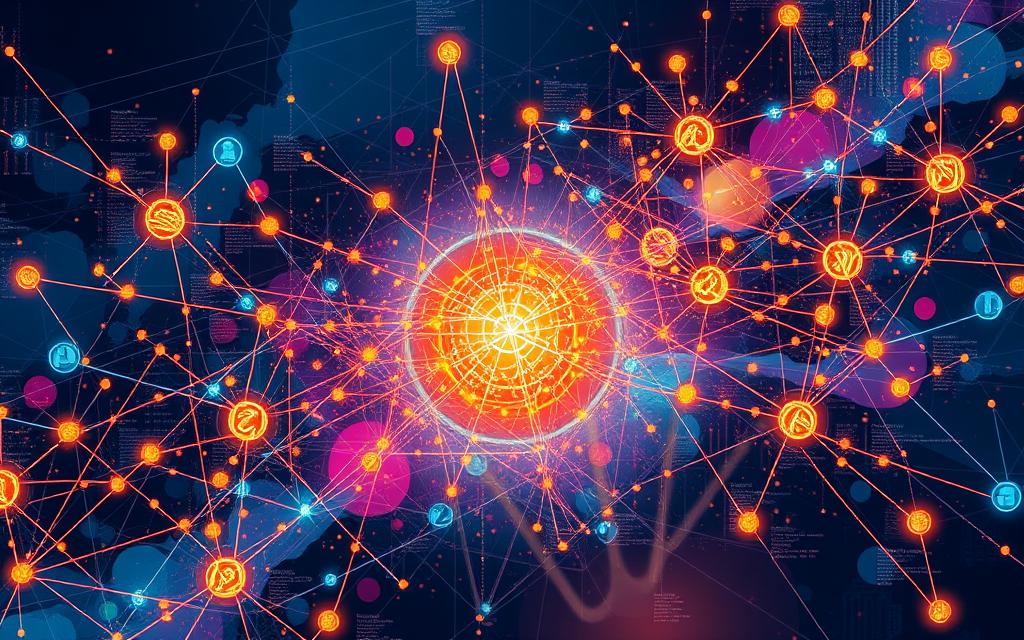In the world of blockchain, a key innovation has emerged – the oracle. It’s like a bridge that connects the rigid blockchain networks with the dynamic real world. Oracles link off-chain data to the secure, unchangeable ledgers on-chain.
Think about this: a farmer in the Midwest uses a smart contract for insurance that works with real-time weather. A big company uses smart contracts that adjust to market prices for its global operations. Oracles make this possible by bringing in data that was once out of reach.
Oracles break down the walls of blockchain’s own world. They let decentralized apps work with real-world data, not just on their own. This way, apps can be more relevant and useful.
Key Takeaways
- Oracles make it possible to add decentralized data integration to smart contracts, bringing in real-world data.
- They are key for secure data sharing between the real world and blockchain networks, enabling advanced app functions.
- Hybrid smart contracts use outside data, like weather or market changes, showing a big step forward.
- The accuracy of oracles depends on the quality and variety of the data they use.
- With systems like Flare’s FTSOv2, oracles can now handle more data more often.
- Staking in oracle systems, like with Flare, shows people trust oracles more for keeping things secure.
- Understanding both the fixed data on blockchain and the changing data from the world outside is key for blockchain’s growth.
Understanding Blockchain Oracles and Their Purpose
Blockchain oracles have greatly improved how smart contracts work. They connect digital contracts with real-world data. This makes blockchains useful beyond their limits.
Definition of Blockchain Oracles
Blockchain oracles are third-party services. They bring in data from outside the blockchain. This data can be things like live prices or weather updates.
Significance of Oracles in Smart Contract Execution
Oracles play a big role in making sure data is correct and can’t be tampered with. They help smart contracts make decisions based on real-world data. This makes decentralized apps more useful in areas like finance and logistics.
The Distinction Between On-Chain and Off-Chain Data
There’s a big difference between data stored on the blockchain and data from outside it. Blockchain oracles help move this outside data into the blockchain. This keeps the system working well.
Blockchain oracles are key to smart contracts working well. They make it possible for blockchains to use outside data. This makes decentralized apps more secure and reliable.
The Mechanics of How Oracles Work
To understand data oracle networks in blockchain, we must see the whole process. Oracles connect the blockchain world with real data. They help apps talk to outside info smoothly.
From Data Fetching to Smart Contract Implementation
Oracles start by getting data for smart contracts. This data comes from places like financial markets or weather services. After getting the data, it’s checked to make sure it’s right.
Oracles like Chainlink use special methods to keep data safe. This helps avoid problems with centralized systems.
Case Studies: Real-World Applications of Oracles in Action
Decentralized Finance (DeFi) needs oracles to link with real financial data. For example, Chainlink Price Feeds help keep stablecoin values stable. They also help with insurance payouts based on market changes.
Insurance uses oracles to check claims and settle them quickly. This is based on things like weather or health data.
Oracles also connect Internet of Things (IoT) devices with blockchain. This makes industries like supply chain and manufacturing work better.

| Functionality | Application | Example |
|---|---|---|
| Chainlink Price Feeds | DeFi | Securing billion-dollar contracts |
| Input Oracles | Fetching Data | Chainlink fetching for DeFi |
| Output Oracles | Triggering Off-Chain Actions | Payments, IoT interactions |
| Cross-Chain Oracles | Interoperability | Linking different blockchains |
| Compute-Enabled Oracles | Advanced Computations | Off-chain computation services |
Oracles play a key role in blockchain. They connect the blockchain world with the outside. This helps drive innovation in many areas.
Different Types of Oracles in Blockchain Ecosystems
Blockchain oracles are key players in digital ecosystems. They connect external data to blockchain’s closed environment. This connection is vital for blockchain applications to work well.
Decentralized data feeds, off-chain data integration, and cross-chain data bridges are essential. They make blockchain systems more reliable and efficient.
Software and Hardware Oracles: Oracles are mainly software or hardware. Software oracles get data from online sources. They provide timely and accurate data for financial apps.
Hardware oracles, on the other hand, get data from the physical world. They use IoT sensors. This allows blockchain to react to real-world events automatically.
Inbound and Outbound Oracles: Oracles can also be inbound or outbound. Inbound oracles bring external data into blockchain systems. This is important for apps like DeFi that need real-time info.
Outbound oracles let blockchains send commands to the outside world. This makes blockchain’s impact go beyond the digital space.
Decentralized Oracle Networks: These networks focus on decentralized data feeds. They use many data points verified by different nodes. This makes the system more reliable and less prone to failures.
Consensus-based Oracles: These oracles are all about accuracy. They gather data and need a consensus to validate it. This makes the data more reliable for smart contracts, which is great for DeFi.
Cross-Chain Data Bridges: Cross-chain oracles help different blockchain networks work together. They make data and asset transfer smooth. This creates a more connected blockchain ecosystem.
| Type | Main Function | Use Case |
|---|---|---|
| Software Oracles | Digital Data Retrieval | Real-time stock prices for financial dApps |
| Hardware Oracles | Sensing Physical Events | Weather data integration for crop insurance |
| Inbound Oracles | Data to Blockchain | Importing external data into smart contracts |
| Outbound Oracles | Blockchain to External World | Activating payments upon smart contract conditions |
| Cross-Chain Oracles | Interoperability Support | Asset transfers between different blockchains |
Each oracle type has its own role. They can greatly improve how blockchain apps work. By using off-chain data integration and cross-chain data bridges, they meet various business and tech needs.
Challenges and Solutions in Oracle Technology
Oracles are key in blockchain but face challenges. These include risks from centralization, trust issues, and security problems. These can harm the trustworthiness of smart contracts.
Nearly 90% of smart contracts need data from outside the blockchain. This makes oracles very important. But, centralized oracles can be single points of failure, leading to data tampering worries.
Addressing the Risks of Centralization in Oracle Design
Decentralized Oracle Networks (DONs) like Chainlink Price Feeds offer a solution. They use many sources for data, making it more reliable. This helps keep blockchain decentralized.
These networks protect smart contracts from single data source risks. The IoT market for Oracle tech is worth $300 billion in 2023. So, secure data transmission through oracles is vital.
Security Considerations and Mitigation Strategies
Security is a big deal in oracle systems. Decentralized oracle networks keep data safe from start to finish. This ensures data integrity and security.
This careful approach to data transmission keeps the oracle system safe. It also makes sure on-chain and off-chain worlds work together smoothly. By decentralizing oracle networks, we avoid single points of failure and lower costs.
